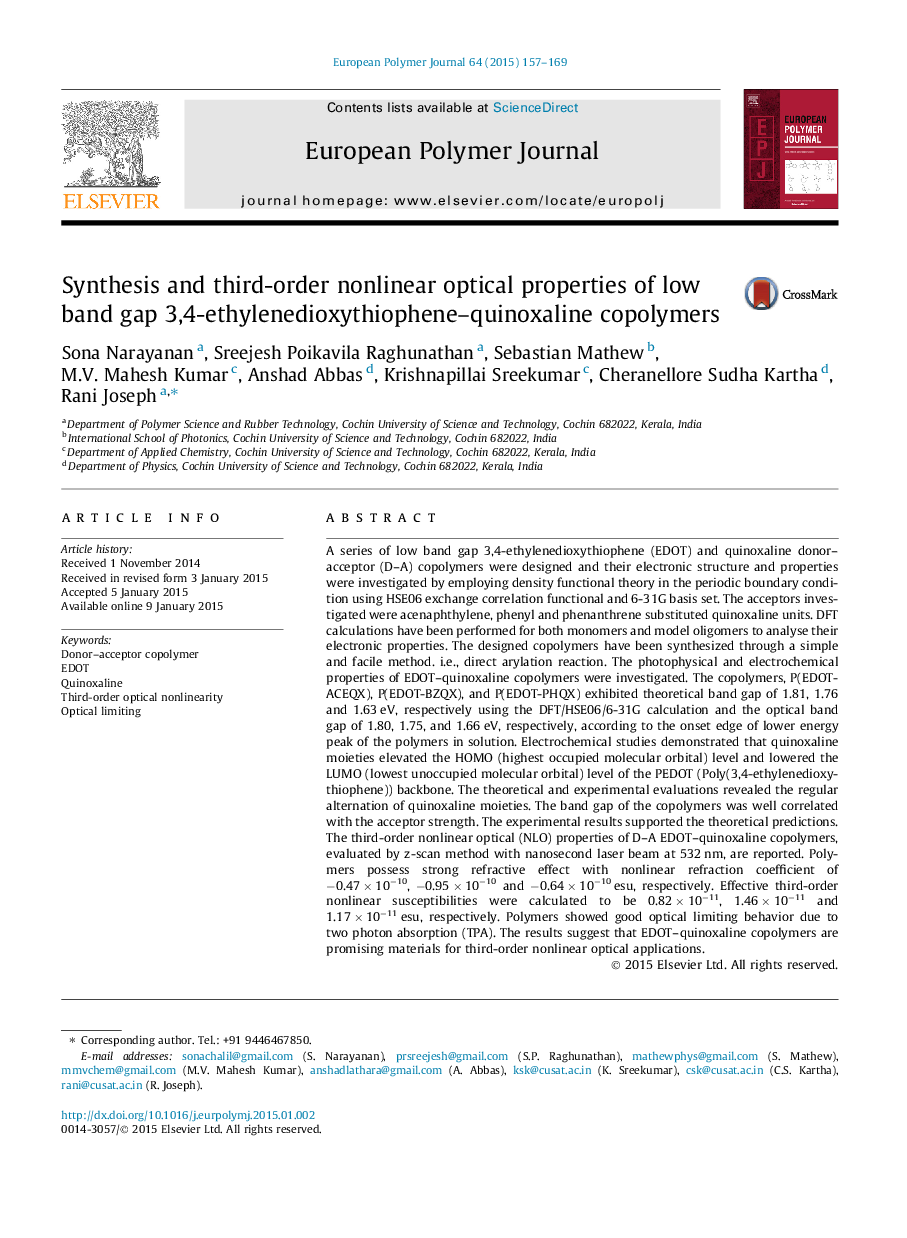| کد مقاله | کد نشریه | سال انتشار | مقاله انگلیسی | نسخه تمام متن |
|---|---|---|---|---|
| 1395281 | 1501371 | 2015 | 13 صفحه PDF | دانلود رایگان |
• Low band gap EDOT–quinoxaline copolymers were synthesized via direct arylation.
• Polymers were characterized by theoretical, optical and electrochemical methods.
• The experimental results supported the theoretical predictions.
• Third-order NLO properties were investigated using z-scan technique.
• Results revealed that polymers are promising materials for photonic applications.
A series of low band gap 3,4-ethylenedioxythiophene (EDOT) and quinoxaline donor–acceptor (D–A) copolymers were designed and their electronic structure and properties were investigated by employing density functional theory in the periodic boundary condition using HSE06 exchange correlation functional and 6-31G basis set. The acceptors investigated were acenaphthylene, phenyl and phenanthrene substituted quinoxaline units. DFT calculations have been performed for both monomers and model oligomers to analyse their electronic properties. The designed copolymers have been synthesized through a simple and facile method. i.e., direct arylation reaction. The photophysical and electrochemical properties of EDOT–quinoxaline copolymers were investigated. The copolymers, P(EDOT-ACEQX), P(EDOT-BZQX), and P(EDOT-PHQX) exhibited theoretical band gap of 1.81, 1.76 and 1.63 eV, respectively using the DFT/HSE06/6-31G calculation and the optical band gap of 1.80, 1.75, and 1.66 eV, respectively, according to the onset edge of lower energy peak of the polymers in solution. Electrochemical studies demonstrated that quinoxaline moieties elevated the HOMO (highest occupied molecular orbital) level and lowered the LUMO (lowest unoccupied molecular orbital) level of the PEDOT (Poly(3,4-ethylenedioxythiophene)) backbone. The theoretical and experimental evaluations revealed the regular alternation of quinoxaline moieties. The band gap of the copolymers was well correlated with the acceptor strength. The experimental results supported the theoretical predictions. The third-order nonlinear optical (NLO) properties of D–A EDOT–quinoxaline copolymers, evaluated by z-scan method with nanosecond laser beam at 532 nm, are reported. Polymers possess strong refractive effect with nonlinear refraction coefficient of −0.47 × 10−10, −0.95 × 10−10 and −0.64 × 10−10 esu, respectively. Effective third-order nonlinear susceptibilities were calculated to be 0.82 × 10−11, 1.46 × 10−11 and 1.17 × 10−11 esu, respectively. Polymers showed good optical limiting behavior due to two photon absorption (TPA). The results suggest that EDOT–quinoxaline copolymers are promising materials for third-order nonlinear optical applications.
Figure optionsDownload as PowerPoint slide
Journal: European Polymer Journal - Volume 64, March 2015, Pages 157–169
